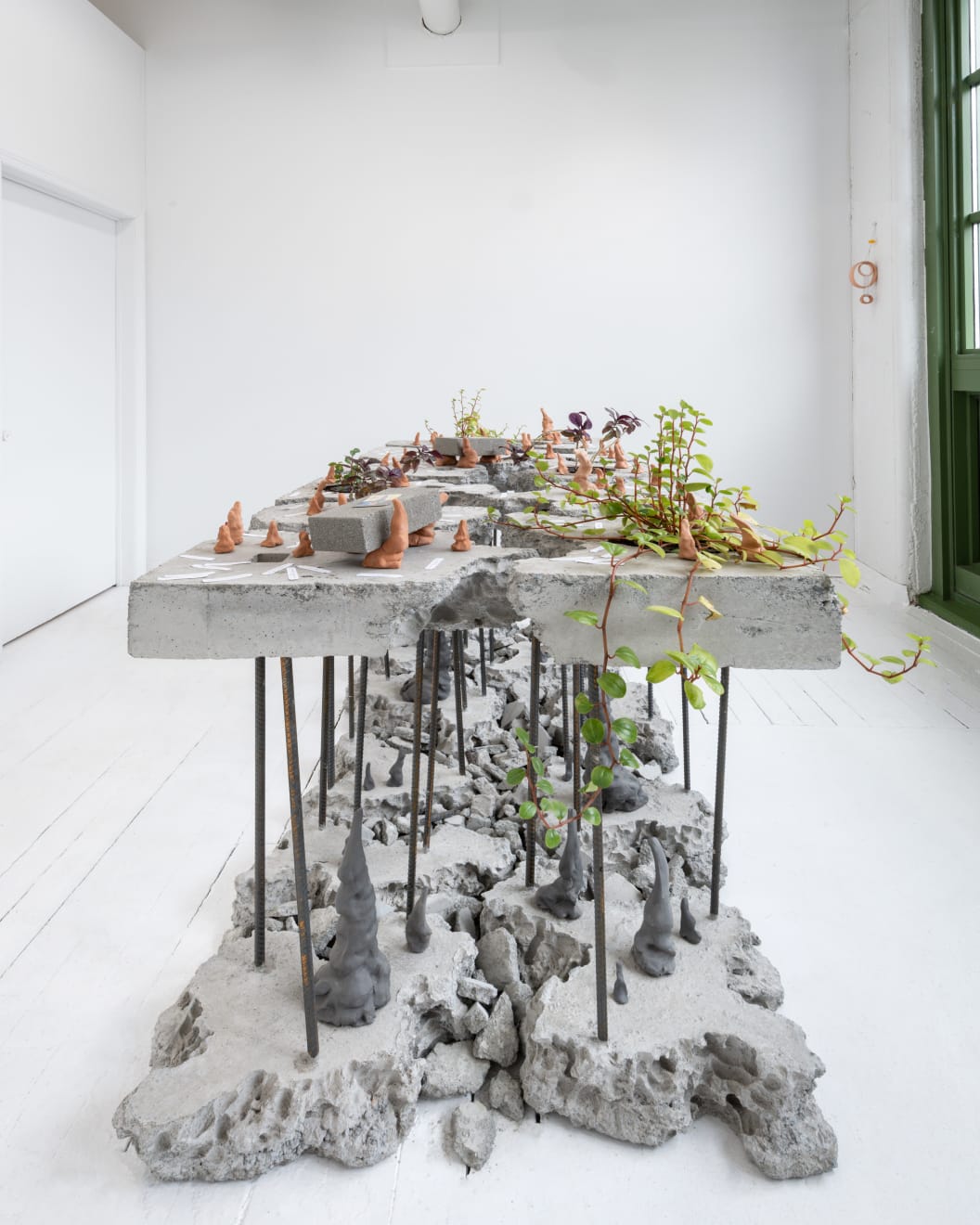Paul Mok
You Are Living Someone Else’s Dream, 2023
Concrete, steel, clay, photograph, paper, plants, faucet
48 x 30 x 85 in
121.9 x 76.2 x 215.9 cm
121.9 x 76.2 x 215.9 cm
PM0001
Copyright The Artist
Further images
Consisting of a long “table,” roughly 2.5 by 7 ft (0.7 x 21. m), and resembling a broken piece of concrete slab from an abandoned basement, You Are Living Someone...
Consisting of a long “table,” roughly 2.5 by 7 ft (0.7 x 21. m), and resembling a broken piece of concrete slab from an abandoned basement, You Are Living Someone Else’s Dream (2023) was first conceived when Mok was living in a basement as a foreigner whose visa was about to expire. On the table, pieces of paper read like fortune cookie strips. But they are actually all sentences the artist wrote when he was contemplating what to put on this table in order to reveal the condition under which the artwork was conceived. It’s practically possible to put all these sentences back together to reconstruct the original writing, but the answer to “what’s on the table” will only be the artist’s original struggle in deciding what, indeed, to put on the table: “The struggle in meaning-seeking will be answered with the original struggle in meaning-making.” The artist asks, “Is it possible to fully demonstrate a first-person experience, one’s struggles and failures in making sense of one’s circumstances? Is it possible to show a sculpture as what it truly is – an unfinished attempt at meaning-making?” Mok employs a complex constellation of objects, ranging from industrial building materials and childhood photographs to handmade clay sculptures and living plants. An encyclopedic and accumulative environment, the “table” appears salvaged from a world abandoned by humans, in which plants and other creatures have begun to take over. What remains from humanity are the infrastructural ruins (the savaged concrete table) and some form of broken narrative (the cookie strips). The notion of “table,” when used as a verb; e.g., to “table” something, implies neglecting or postponing dealing with something. “I think that’s what I did to my childhood self. Over the years, I ended up suppressing, denying and despising who I was as a kid. “What's on the table” also means the things that are available for a bargain: what one is willing to trade/give up. And I think I have always traded that side of me for my career, my ambitions, etc. Yet, I think it was that “kid” who has been quietly making all these artworks in the past years. It's likely also where the anxiety captured in the fortune cookie strips stems from.”
Tracing the use of concrete in his work, Mok recalls his experience in Hiroshima: “I visited the Hiroshima Peace Memorial in 2017. It was originally an industrial hall, and it was one of the very few buildings that remained standing after the bombing (because it was built out of concrete, steel and bricks, not wood). They kept it in its ruined state to memorialize the atrocities humans have committed against one another. What moved me were the plants. They were growing out of the cracks, covering the floor. They were flourishing.”
Through a proliferation of textures and complex constellations of object, visual artist, designer and architect Paul Mok (b. 1990, Hong Kong) embeds his nuanced aesthetic language into the surfaces of industrial materials and extends into the psychological realm—dismantling material hierarchy and collapsing distinctions among categories. Mok lives and works in Brooklyn, New York. Mok graduated with a bachelor's degree in architectural studies from the University of Hong Kong and a master’s degree in architecture from the Harvard Graduate School of Design. He has exhibited at venues such as New Collectors, Art on Paper at Pier 36, Gallery GAIA and Art Mora Gallery. He has been featured in publications such as Cultured Magazine, Wallpaper, Whitehot Magazine, FAD, Art Spiel, Pattern, and Cultbyte. In 2022, Mok was named one of the Young Architects by Cultured Magazine.
Tracing the use of concrete in his work, Mok recalls his experience in Hiroshima: “I visited the Hiroshima Peace Memorial in 2017. It was originally an industrial hall, and it was one of the very few buildings that remained standing after the bombing (because it was built out of concrete, steel and bricks, not wood). They kept it in its ruined state to memorialize the atrocities humans have committed against one another. What moved me were the plants. They were growing out of the cracks, covering the floor. They were flourishing.”
Through a proliferation of textures and complex constellations of object, visual artist, designer and architect Paul Mok (b. 1990, Hong Kong) embeds his nuanced aesthetic language into the surfaces of industrial materials and extends into the psychological realm—dismantling material hierarchy and collapsing distinctions among categories. Mok lives and works in Brooklyn, New York. Mok graduated with a bachelor's degree in architectural studies from the University of Hong Kong and a master’s degree in architecture from the Harvard Graduate School of Design. He has exhibited at venues such as New Collectors, Art on Paper at Pier 36, Gallery GAIA and Art Mora Gallery. He has been featured in publications such as Cultured Magazine, Wallpaper, Whitehot Magazine, FAD, Art Spiel, Pattern, and Cultbyte. In 2022, Mok was named one of the Young Architects by Cultured Magazine.
1
/
4













